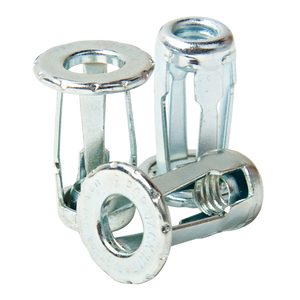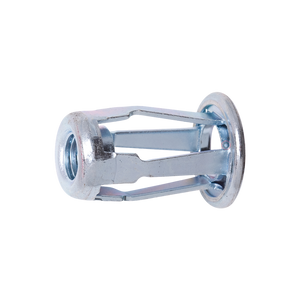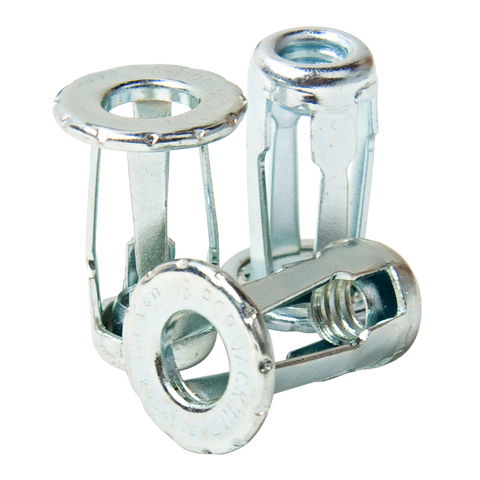Recommended Nutsert Installation Tools
Jack Nut Threaded Inserts - Steel
Brands you know and trust - Aerobolt
Jack Nuts for plastics, ply and more.
Jack Nuts provide a rivet nut solution in non-load bearing applications. Upon installation, the slotted sleeves collapses to form a propeller shape configuration which gently grips the inside of the mounting surface - providing a screw anchor. Ideal for numerous lightweight materials including cardboard and plastics. Jack Nuts are a cost saving alternative to Plus Nut that can also accommodate oversized holes and be installed in uneven materials without distorting the material. Check the nutsert blog.
Jack Nuts - The Slotted Body Threaded Inserts for Cardboard, Plastic & More.
JackNuts or J Nuts are an economical threaded insert for assembly-line use in thin, soft, or brittle materials. When tightened, the body collapses to form four legs which grip the inside of the mounting surface, leaving a permanent, reusable threaded for bolt purposest. Jack nuts are ideal for installing a captive thread into materials which would be unsuitable for other techniques, or where the hole is too large for the thread you wish to use.
Jack Nut Features and benefits:
- Fastens in blind holes and wide grip range.
- Won’t distort soft plastics, thin sheet metals.
- Fast, inexpensive, and easy to use.
- Can be set with manual or pneumatic tools.
- Easy to remove and reusable.
Jack Nuts are suitable for the following materials:
- Timber, chipboard, particle board, MDF etc.
- Glass reinforced plastics (GRP).
- Most rigid plastics (PVC, polythene, polypropylene etc.)
- Composites, ceramics, cardboard, glass and so much more.
Jack Nut - Slotted Body Rivet Nut for Lightweight Applications.
A Jack Nut, also known as a JackNut or J Nut is a type of fastener used to create a threaded hole in materials that are thin or where access to the backside is limited. It is commonly used when joining plastic or other lightweight materials that are too thin to support a tapped thread.
A Jack Nut consists of a cylindrical body with a threaded interior and a flange at one end. The exterior of the body has a slotted body, and the other end of the Jack Nut is open to allow access for installation.
Jack Nuts - How to Install.
To install a Jack Nut, a hole is drilled or punched into the material. The Jack Nut is then inserted into the hole, and a tool is used to deform or compress the flange end. This process causes the Jack Nut to expand and grip the material securely. The threaded interior of the Jack Nut provides a reliable and durable anchor point for bolts, screws, or other fasteners.
Jack Nuts are commonly used in industries such as automotive, aerospace, electronics, and manufacturing, where they provide a versatile and efficient method for adding threaded connections to thin or inaccessible materials.
Jack Nuts - The Slotted Body Threaded Inserts for Cardboard, Plastic & More.
JackNuts or J Nuts are an economical threaded insert for assembly-line use in thin, soft, or brittle materials. When tightened, the body collapses to form four legs which grip the inside of the mounting surface, leaving a permanent, reusable threaded for bolt purposest. Jack nuts are ideal for installing a captive thread into materials which would be unsuitable for other techniques, or where the hole is too large for the thread you wish to use.
Jack Nut Features and benefits:
- Fastens in blind holes and wide grip range.
- Won’t distort soft plastics, thin sheet metals.
- Fast, inexpensive, and easy to use.
- Can be set with manual or pneumatic tools.
- Easy to remove and reusable.
Jack Nuts are suitable for the following materials:
- Timber, chipboard, particle board, MDF etc.
- Glass reinforced plastics (GRP).
- Most rigid plastics (PVC, polythene, polypropylene etc.)
- Composites, ceramics, cardboard, glass and so much more.
Jack Nut - Slotted Body Rivet Nut for Lightweight Applications.
A Jack Nut, also known as a JackNut or J Nut is a type of fastener used to create a threaded hole in materials that are thin or where access to the backside is limited. It is commonly used when joining plastic or other lightweight materials that are too thin to support a tapped thread.
A Jack Nut consists of a cylindrical body with a threaded interior and a flange at one end. The exterior of the body has a slotted body, and the other end of the Jack Nut is open to allow access for installation.
Jack Nuts - How to Install.
To install a Jack Nut, a hole is drilled or punched into the material. The Jack Nut is then inserted into the hole, and a tool is used to deform or compress the flange end. This process causes the Jack Nut to expand and grip the material securely. The threaded interior of the Jack Nut provides a reliable and durable anchor point for bolts, screws, or other fasteners.
Jack Nuts are commonly used in industries such as automotive, aerospace, electronics, and manufacturing, where they provide a versatile and efficient method for adding threaded connections to thin or inaccessible materials.











